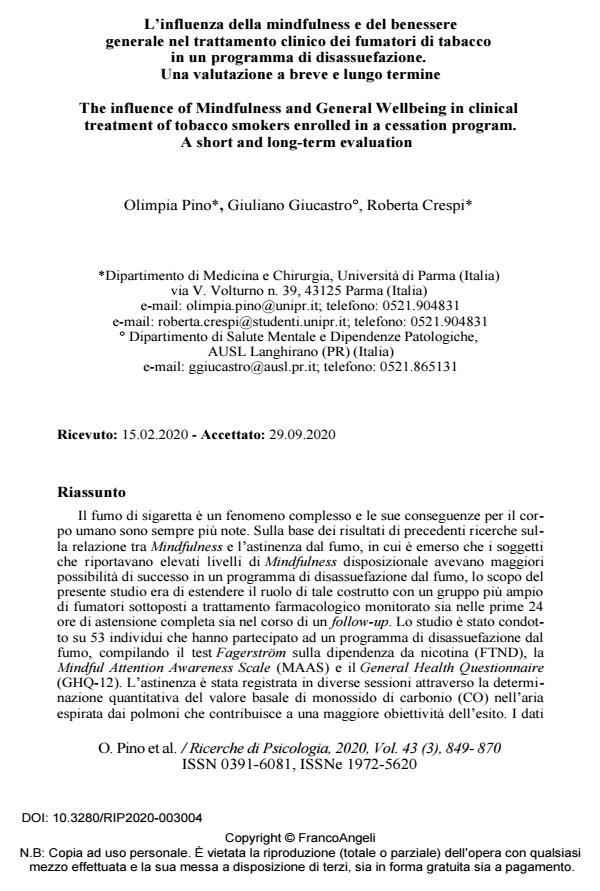L’influenza della mindfulness e del benessere generale nel trattamento clinico dei fumatori di tabacco in un programma di disassuefazione. Una valutazione a breve e lungo termine
Titolo Rivista RICERCHE DI PSICOLOGIA
Autori/Curatori Olimpia Pino, Giuliano Giucastro, Roberta Crespi
Anno di pubblicazione 2020 Fascicolo 2020/3
Lingua Italiano Numero pagine 22 P. 849-870 Dimensione file 279 KB
DOI 10.3280/RIP2020-003004
Il DOI è il codice a barre della proprietà intellettuale: per saperne di più
clicca qui
Qui sotto puoi vedere in anteprima la prima pagina di questo articolo.
Se questo articolo ti interessa, lo puoi acquistare (e scaricare in formato pdf) seguendo le facili indicazioni per acquistare il download credit. Acquista Download Credits per scaricare questo Articolo in formato PDF

FrancoAngeli è membro della Publishers International Linking Association, Inc (PILA)associazione indipendente e non profit per facilitare (attraverso i servizi tecnologici implementati da CrossRef.org) l’accesso degli studiosi ai contenuti digitali nelle pubblicazioni professionali e scientifiche
Il fumo di sigaretta è un fenomeno complesso e le sue conseguenze per il cor-po umano sono sempre più note. Sulla base dei risultati di precedenti ricerche sul-la relazione tra Mindfulness e l’astinenza dal fumo, in cui è emerso che i soggetti che riportavano elevati livelli di Mindfulness disposizionale avevano maggiori possibilità di successo in un programma di disassuefazione dal fumo, lo scopo del presente studio era di estendere il ruolo di tale costrutto con un gruppo più ampio di fumatori sottoposti a trattamento farmacologico monitorato sia nelle prime 24 ore di astensione completa sia nel corso di un follow-up. Lo studio è stato condotto su 53 individui che hanno partecipato ad un programma di disas-suefazione dal fumo, compilando il test Fagerström sulla dipendenza da nicotina (FTND), la Mindful Attention Awareness Scale (MAAS) e il General Health Que-stionnaire (GHQ-12). L’astinenza è stata registrata in diverse sessioni attraverso la determinazione quantitativa del valore basale di monossido di carbonio (CO) nell’aria espirata dai polmoni che contribuisce a una maggiore obiettività dell’esito. I dati non hanno confermato il ruolo della Mindfulness come preditto-re dell’astinenza. I punteggi MAAS e GHQ-12 non appaiono correlati all’esito del programma di cessazione dal fumo di sigaretta. L’uso di strumenti più sensibili nella rilevazione della Mindfulness disposizionale potrebbe portare a risultati più accurati. Un trattamento cognitivo comportamentale più strutturato potrebbe contribuire alla cessazione della dipendenza da tabacco.
Parole chiave:Dipendenza da nicotina, dipendenza da tabacco, fumo, pro-gramma di cessazione dal fumo di sigaretta, mindfulness.
Olimpia Pino, Giuliano Giucastro, Roberta Crespi, L’influenza della mindfulness e del benessere generale nel trattamento clinico dei fumatori di tabacco in un programma di disassuefazione. Una valutazione a breve e lungo termine in "RICERCHE DI PSICOLOGIA " 3/2020, pp 849-870, DOI: 10.3280/RIP2020-003004